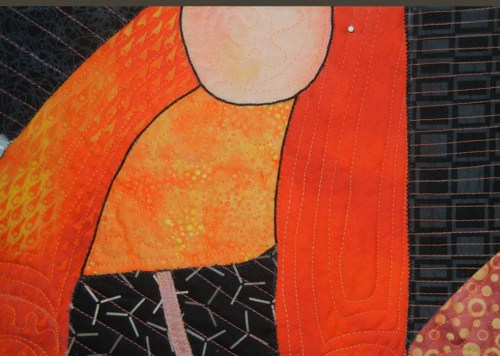After so much experimentation with paint and collage I was anxious to see if and how it might translate to fabric. I gave myself this assignment:
– Make 4 small collages, each with paint used at least once.
– Experiment with different ways to get a sheer/transparent effect.
– Start with materials immediately on my work table.
– Start by adding something sheer to every stage.
These were my initial materials, all of which were lying around, (i.e. not properly put away.) They included some hexies which had been stitched to a background piece of muslin, small fused scraps and sheer fabrics.

I cut up the hexies and used them as part of the backgrounds.

I expected the finished compositions to be about 5 x 7. I used a paper frame (above) to help me arrange the hexies for each. These were my starting compositions.

I’ll show you some of what I did. However, I don’t consider any of them finished. As a matter of fact, I wasn’t very happy with any of them. But, I managed to answer my questions, so then I felt find about putting them away.
This is as far as I got on the orange one. As you can see, a layer of organza greatly obscured the layer below. It’s also got paint on top of everything you see here. Except for the little black line which I added with stitching.

This red and green one got a transparent layer with over printing. I liked that effect. Yellow lines were fused on and organza was added to the right side only.

This blue one was pretty much a dud. I added a gridded sheer and then melted parts of it with a heat gun. I didn’t like the wounds. I also used heavy stitching as a transparent layer. It worked pretty well, but was too much work for my liking.

This one was quickly getting overworked and it had questionable color choices. But, I did like the line I added with two lines of stitching.

And here it is when it got so ugly I couldn’t face it anymore!

With all this ugliness, what did I learn?
– I don’t really like sheer fabrics as translucent layers. They tend to obscure the lower layers too much.
– I DO like allover printing as a textural/sheer layer. I can see myself using it again.
– I like adding a black line with machine stitching. I’d like to explore hand stitching it too.
I think I’ve now well and thoroughly put this episode of exploration to bed. On to the next thing!
Ellen Lindner
































